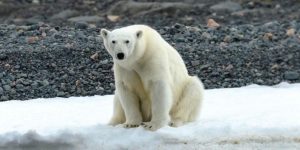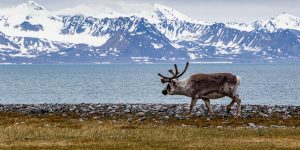The Svalbard archipelago is made of up four large mountainous islands and hundreds of smaller ones. Spitsbergen is the largest island located halfway between Norway and the North Pole. Remote and untouched, it was a staging point for many expeditions to the North Pole. It is a wildlife playground, with the majestic polar bear at the top of the food chain, along with thousands of migratory seabirds nesting on the coastal cliffs, as well as walrus, whales and many seals.
Polar Bears
Check this off your bucket list by going to Spitsbergen!
 The odds of spotting this most iconic resident are good, thanks to the large number that live in the region of Svalbard, the archipelago of islands in the region of Norway. As polar bears spend much of their time hunting seal on sea ice, they are often seen from the water, travelling on the sea ice in search of prey. The largest land carnivore in the world, the male polar bear can stand 6.25–7.75 feet
The odds of spotting this most iconic resident are good, thanks to the large number that live in the region of Svalbard, the archipelago of islands in the region of Norway. As polar bears spend much of their time hunting seal on sea ice, they are often seen from the water, travelling on the sea ice in search of prey. The largest land carnivore in the world, the male polar bear can stand 6.25–7.75 feet
tall (1.9–2.36 meters) and weigh as much as 1,433 lbs (650 kilos). The female is slightly smaller, weighing in at around 330–660 lbs, or 150–300 kilos.
Did you know?
There are more polar bears than humans living in Svalbard. The polar bear is a prolific hunter, with an expansive home range. In the community of Longyearbyen, one is required to carry a high powered firearm when leaving the settlement. Polar bears can be curious, and need to be viewed from a safe distance!
Wildlife
Wildlife in the Svalbard region and on Spitsbergen have had to adapt to extreme conditions in order to survive. As a result, there are few species, but those that have adapted are greater in number. Food is the greatest challenge, especially during the dark winter months. Arctic fox and Svalbard reindeer have adapted by spending the summer building a layer of body fat for winter survival. Other prolific species include walrus, many whale species and five types of seal. Only walrus, narwhal and bowhead whales stay in the area year-round, with the rest returning during summer months. It’s those months that give Spitsbergen its reputation as the place for arctic wildlife viewing.
Hiking & Zodiac Cruising in Spitsbergen
The wilderness surrounding Longyearbyen, the northernmost city in the world on the island of Spitsbergen, provides ample hiking opportunities for every experience level. The tundra can be surprisingly colorful in the summertime, with wildflowers, moss and lichen taking advantage of the short season. Glaciers and rocky peaks beg to be explored, and you never know when you’ll come across an ancient abandoned hut or encampment.
From the water, on board a Zodiac, there are many opportunities to spot wildlife and see, hear and smell the chaos of an arctic bird cliff from the water. Or, if you’re lucky, witness a walrus haul-out. The giant creatures create quite a scene as they vie for a choice spot of coastline.
Come experience the beauty of Spitsbergen. The Arctic is calling.

